E2 reaction - Study guides, Class notes & Summaries
Looking for the best study guides, study notes and summaries about E2 reaction? On this page you'll find 472 study documents about E2 reaction.
Page 3 out of 472 results
Sort by
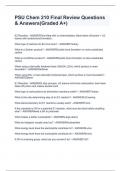
-
PSU Chem 210 Final Review Questions & Answers(Graded A+)
- Exam (elaborations) • 3 pages • 2024
- Available in package deal
-
- $9.99
- + learn more
PSU Chem 210 Final Review Questions & Answers(Graded A+) E2 Reaction - ANSWEROne-Step with no intermediates, Base takes off proton + LG leaves with double bond formation. What type of carbons do E2 rxns favor? - ANSWERTertiary What is a Zaitsev product? - ANSWERDouble bond formation on more substituted carbon What is a Hoffman product? - ANSWERDouble bond formation on less substituted carbon When using a stericallly hindered base (t-BuOK, LDA), which product is more favorable? - A...
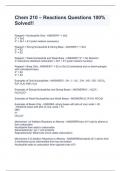
-
Chem 210 – Reactions Questions 100% Solved!!
- Exam (elaborations) • 6 pages • 2024
- Available in package deal
-
- $11.99
- + learn more
Reagent = Nucleophile Only - ANSWER1° = Sn2 2° = Sn2 3° = Sn1 + E1 (polar medium necessary) Reagent = Strong Nucleophile & Strong Base - ANSWER1° = Sn2 2° = E2 3° = E2 Reagent = Weak Nucleophile and Weak Base - ANSWER1°/2° = No Reaction 3°/resonance stabilized carbocation = Sn1 + E1 (polar medium necessry Reagent = Base Only - ANSWER1° = E2 or Sn2 (if unhindered and no beta-hydrogen with unhindered base) 2° = E2 3° = E2 Examples of Only Nucleophiles - ANSWERCl⁻, ...
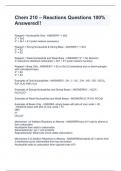
-
Chem 210 – Reactions Questions 100% Answered!!
- Exam (elaborations) • 6 pages • 2024
- Available in package deal
-
- $10.99
- + learn more
Chem 210 – Reactions Questions 100% Answered!! Reagent = Nucleophile Only - ANSWER1° = Sn2 2° = Sn2 3° = Sn1 + E1 (polar medium necessary) Reagent = Strong Nucleophile & Strong Base - ANSWER1° = Sn2 2° = E2 3° = E2 Reagent = Weak Nucleophile and Weak Base - ANSWER1°/2° = No Reaction 3°/resonance stabilized carbocation = Sn1 + E1 (polar medium necessry Reagent = Base Only - ANSWER1° = E2 or Sn2 (if unhindered and no beta-hydrogen with unhindered base) 2° = E2 3° = E...

-
THE Test Bank for Chemistry 6th Edition Gilbert
- Exam (elaborations) • 140 pages • 2024
-
- $13.49
- + learn more
W. W. Norton & Company has been independent since its founding in 1923, when William Warder Norton and Mary D. Herter Norton first published lectures delivered at the People’s Institute, the adult education division of New York City’s Cooper Union. The firm soon expanded its program beyond the Institute, publishing books by celebrated academics from America and abroad. By midcentury, the two major pillars of Norton’s publishing program—trade books and college texts—were firmly estab...
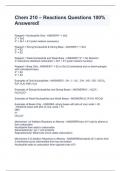
-
Chem 210 – Reactions Questions 100% Answered!
- Exam (elaborations) • 6 pages • 2024
- Available in package deal
-
- $13.99
- + learn more
Reagent = Nucleophile Only - ANSWER1° = Sn2 2° = Sn2 3° = Sn1 + E1 (polar medium necessary) Reagent = Strong Nucleophile & Strong Base - ANSWER1° = Sn2 2° = E2 3° = E2 Reagent = Weak Nucleophile and Weak Base - ANSWER1°/2° = No Reaction 3°/resonance stabilized carbocation = Sn1 + E1 (polar medium necessry Reagent = Base Only - ANSWER1° = E2 or Sn2 (if unhindered and no beta-hydrogen with unhindered base) 2° = E2 3° = E2 Examples of Only Nucleophiles - ANSWERCl⁻, ...
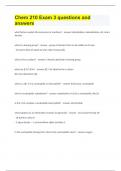
-
Chem 210 Exam 3 questions and answers
- Exam (elaborations) • 11 pages • 2023
- Available in package deal
-
- $14.99
- + learn more
what factors explain the outcomes of reactions? hybridization, delocalization, eN, atom density what is a leaving group? - group of atom(s) that can be stable on its own - eN atoms that are good LG also make strong acids what is the α carbon? C directly attached to leaving group what are β Cs? β Hs? βC: C(s) attached to α carbon βH: H(s) attached to βC what is a LB? is it a nucleophile or electrophile? lewis base, nucleophile what is nucleophilic ...
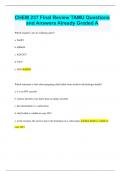
-
CHEM 237 Final Review TAMU Questions and Answers Already Graded A
- Exam (elaborations) • 46 pages • 2023
- Available in package deal
-
- $11.99
- + learn more
CHEM 237 Final Review TAMU Questions and Answers Already Graded A Which reagent is not an oxidizing agent? a. NaOCl b. KMnO4 c. K2Cr2O7 d. CrO3 e. H2O H2O Which statement is false about preparing alkyl halide from alcohol with hydrogen halide? a. it is an SN1 reaction b. tertiary alcohols react faster than secondary alcohols c. the intermediate is a carbocation d. alkyl halide is soluble in conc. HCl e. in the reaction, the slowest step is the formation of a carbocation alkyl halide is...
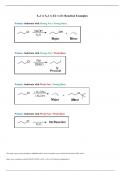
-
CHM 2210 SN2 vs SN1 vs E2 vs E1 Reaction Examples
- Other • 5 pages • 2023
-
- $15.49
- + learn more
SN2 vs SN1 vs E2 vs E1 Reaction Examples Primary Substrate with Strong Nuc / Strong Base: Primary Substrate with Strong Nuc / Weak Base: Primary Substrate with Weak Nuc / Strong Base: Primary Substrate with Weak Nuc / Weak Base:
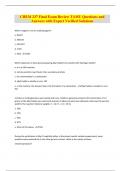
-
CHEM 237 Final Exam Review TAMU Questions and Answers with Expert Verified Solutions
- Exam (elaborations) • 29 pages • 2024
- Available in package deal
-
- $12.44
- + learn more
Which reagent is not an oxidizing agent? a. NaOCl b. KMnO4 c. K2Cr2O7 d. CrO3 e. H2O - H2O Which statement is false about preparing alkyl halide from alcohol with hydrogen halide? a. it is an SN1 reaction b. tertiary alcohols react faster than secondary alcohols c. the intermediate is a carbocation d. alkyl halide is soluble in conc. HCl e. in the reaction, the slowest step is the formation of a carbocation - alkyl halide is soluble in conc. HCl 2‐Chloro‐2‐methylpentane was tr...
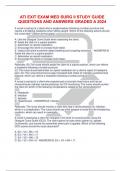
-
ATI EXIT EXAM MED SURG II STUDY GUIDE QUESTIONS AND ANSWERS GRADED A 2024
- Exam (elaborations) • 32 pages • 2024
-
- $15.99
- + learn more
A nurse is caring for a client who is postprocedure following a lumbar puncture and reports a throbbing headache when sitting upright. Which of the following actions should the nurse take? (Select all that apply). A. Use the Glasgow Coma Scale when assessing the client. B. Assist the client to a supine position. C. Administer an opioid medication. D. Encourage the client to increase fluid intake. E. Instruct the client to perform deep breathing and coughing exercises. - ANSWERS-B. Assist ...

$6.50 for your textbook summary multiplied by 100 fellow students... Do the math: that's a lot of money! Don't be a thief of your own wallet and start uploading yours now. Discover all about earning on Stuvia


